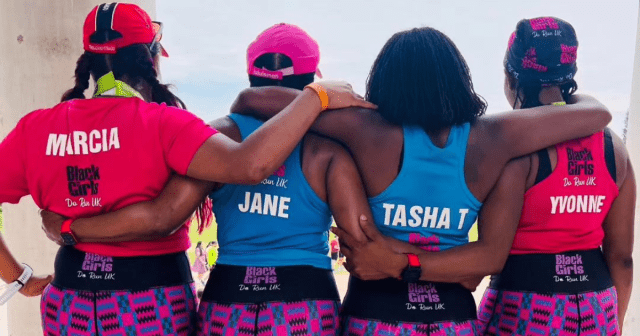For many runners, spring means one thing and one thing only: It’s race time! If you’re one of them, here’s a marathon race plan that will help you nail your race.
Marathon runners from all backgrounds share the same goal (with a slightly different angle, of course) – from those seasoned club animals chasing a PB right through to the nervous first-timers looking to get around 26.2 miles while fundraising for charity.
We all dream of crossing the finish line many times between now and race day.
Suddenly, my email inbox, Twitter feed and phone are filled with messages from people looking for an answer to the usual pre-race dilemma:
“How should I run or race this marathon?”
It’s a question I get asked hundreds of times in the build-up to many big races, especially before a marathon, which evokes fears, stories and memories. For the marathon, we need to have a clear strategy on the start line if we want to see success.
I want to talk about the way to run your perfect marathon but these suggestions and top tips will apply to most other racing distances, too. We want to focus from the moment the gun goes off until the moment we cross the finish line with arms raised in a blaze of personal glory – the moment you hit that target, run that personal record or achieve your goal.
It’s time to find that perfect racing strategy for your marathon.
Marathon RACE PLAN split into three phases
To help you experience that moment of glory, we’re going to split our marathon race plan into three phases. This strategy will help the first timer to get around safely as well as the goal hunter and PB chaser to achieve their dreams.
Each phase requires some thought but above all, you need to believe in your plan when you wake up on marathon race morning. Yes, you will be nervous but make sure you take your normal pre-long run/race breakfast, remain hydrated and enter the start pen on time knowing exactly what you want to do.
Then, it’s time to make it happen.
marathon race plan, PHASE 1 – The B of the Bang
Okay, so you hear the gun sound and adrenalin surges through your body like liquid gold. You may have felt sluggish and pretty average to be honest on many of your training runs during the taper and this is totally normal. Your body was clever and protected its energy storages already saving itself for the big day.
But now the game is on!
However, this is perhaps the most dangerous point of the marathon and any race. This is the moment when adrenalin can take over but you need to hold back, almost take a step backwards before going forward.
If you’re a first-timer looking to get through the run smiling and enjoying the day, don’t worry about the pen being crowded or the slow walk to the start line. Your time starts as the chip sounds and you cross the line. Your aim is to gradually pick up your pace when there is space and spend the first few miles getting into your stride. You may be slower than planned in the first few miles but don’t panic, you have plenty of time.
If you’re hunting for a better time or a PB, you’re probably anxious and ready to hit that first vital split, but remember that you also have plenty of time.
Pro tips
- Avoid zigzagging in a panic because the road is slow and crowded. Your first few miles are about warming up and getting to mile three feeling good and by then on the right pace. Any seconds lost can easily be made up gradually in the next 10 miles.
- Keep to your training zones. Use your watch to check the time splits but also be sure you are in your zone. Relax and run according to your plan, the one you practiced in those long runs!
marathon race plan, PHASE 2 – Cruising and killing time
The marathon begins at 20 miles.
It’s all about how to run, control and enjoy the race from mile three to 20. It’s time to listen to your body, stay in the right zone, keep the focus, take a drink if needed as you pass a station and feel great.
It’s all about recreating whatever worked for you in training. Don’t change your nutrition or hydration strategy now just because others around you take on more or less.
I would recommend a gel every 30-45 mins but it’s all about recreating whatever worked for you in training. Don’t change your nutrition or hydration strategy now just because others around you take on more or less.
For the experienced campaigner, you are now on PB target pace, ticking off the miles and running pretty close to the marathon target pace you became familiar with in those long training runs.
Watch out for the pinch points, like Cutty Sark and Tower Bridge at London, where the hairs on the back of your neck stand up and you feel like an Olympic champion with the crowds screaming. Tell yourself to slow down and keep to that honest pace maybe chatting, taking in the atmosphere or remembering your best training runs.
For the first-timer wanting to conquer the distance, its time to make sure you can still chat easily to the person next to you. We call this running at the speed of chat and it’s a safe way to check you are not pushing too hard.
Pro tips
- If you can’t chat to the runner next to you then you’re definitely running way too fast! If you had planned to walk for 5 minutes every 15 minutes, 5k or 30 minutes, then stick to that plan. It’s your day and your race strategy that counts.
- If you have tapered, the legs will still feel light and you’ll feel as though you are flying along. Many push too hard at this mid point of the race, but I advise you to back off, stick to the plan and enjoy the moment… the real fun lies just a few more miles up the road, I promise!
marathon race plan, Phase 3 – Chasing those vests and keeping that focus
If you have read the script and followed it, then you should arrive at mile 20 working hard but in control. For the experienced, the real racing starts here and now as you begin to laser in on those vests further down the road.
The last 10K should see you up your game gradually as you increase the effort to hold the pace. It’s now time to stop worrying about your mile splits and start GRADUALLY chasing down the vest in front of you, then the next and so on.
This is your strategy to see you home in the final six miles and its time to forget about the pain or what happened in your last race. Draw on the best long runs you banked and how they felt: you’re in great shape and can do this!
I wouldn’t even look at your watch too often, be brave and save that for when you cross the finish line. You don’t need to know what it is telling you at this point as you are now racing those around you and keeping it simple and pure. You can review the data in the post-match analysis!
For those who are entering the final third of a marathon for the first time, it’s the moment to remember a few things and break the race into smaller chunks. You may still chase the vest around and ahead of you but it’s also time to remember all the long runs completed, training sessions and early mornings spent out in the park. This was what you trained for and you feel fantastic.
Pro tips
- Focus on positive thoughts and maybe even remember how your best long run felt, or that training session that you nailed a few weeks ago. Tick each mile off and think only about the mile you are in – don’t worry about the next few… they will all come and pass.
- If you’re running for charity, dedicate each of the last six miles to somebody special in your life. You won’t let them down and they’ll help you through each of these key moments.
- Keep to your strategy and keep chatting. If you feel great, take out the walking sections. If you feel really tired, change things and maybe run 5 mins and walk briskly 5 mins, but keep going. The aches and pains will be there, the legs will feel heavy but this is what makes the marathon and you the marathoner.
You’ll earn the finisher’s medal in the last six miles, not the first, and this was what you trained for.
Imagine your family and friends at key mile markers or landmarks and look forward to seeing them. Make sure your name is on the vest and the crowds will cheer you every step of the way. Maybe dedicate each mile to somebody special in the second half of the race — you won’t want to let them down.
Good luck, be patient and happy hunting!
If you liked this post, don’t forget to share so that others can find it, too.
Or give it a thumbs up!
I like this article
Please note that the information provided in the Polar Blog articles cannot replace individual advice from health professionals. Please consult your physician before starting a new fitness program.






